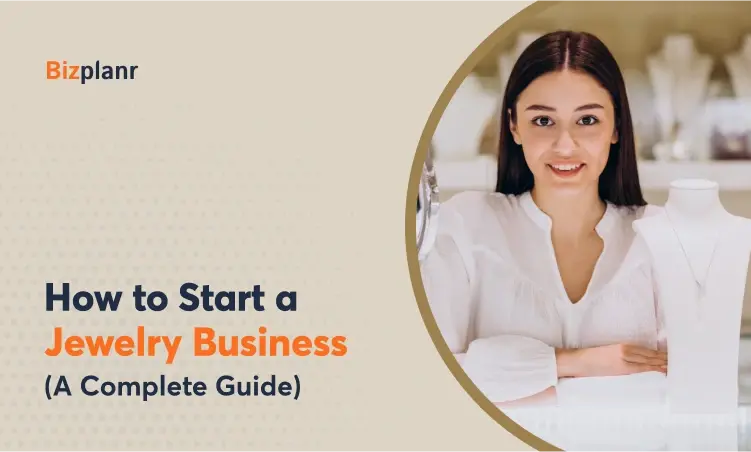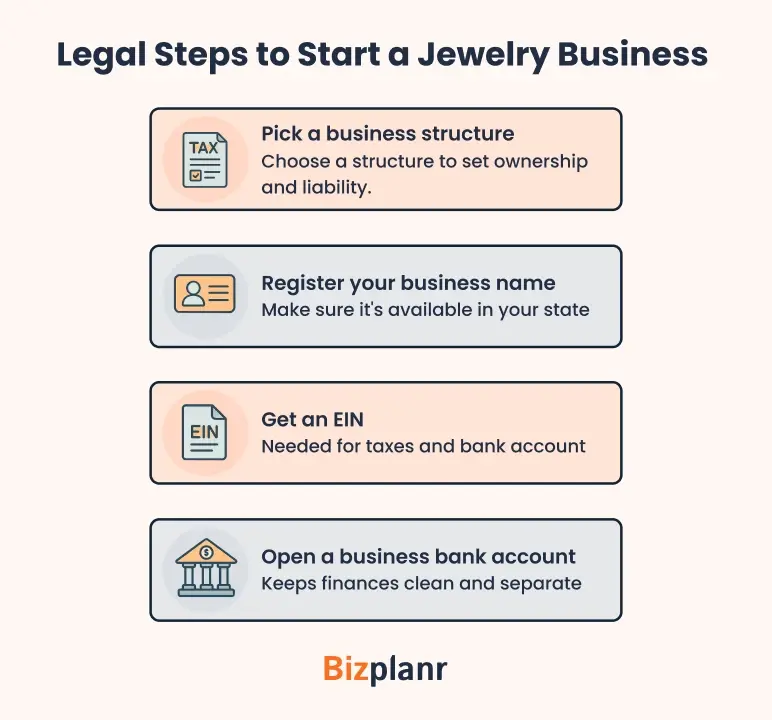Jewelry is personal. It’s often a statement or a sentiment. All-in-all, it’s an exciting business.
However! The market is crowded, your competition already has an Etsy store, a Shopify page, and is shipping the pieces worldwide.
The jewelry industry is heading towards $300+ billion industry by 2032, you’ll need more than just shiny stones to succeed.
This guide covers everything you need to know about how to start a jewelry business. From deciding what kind of jewelry to sell, to building a brand that people remember.
Let’s dive in.
Key Takeaways
- Startup costs range from $500 to $200,000, based on how you source or produce jewelry.
- Your product type and selling model affect both costs and growth potential.
- Success depends on strong branding, quality, and standout product photos.
- You can start lean with made-to-order items and platforms like Etsy or Instagram.
Step 1: Decide what kind of jewelry you’ll sell
Before anything else, ask yourself: Are you making your jewelry, sourcing from other makers, or reselling vintage pieces? Each one comes with its pros and trade-offs.
- Making your own: You control the design and stand out with originality. But it takes time, skill, and tools.
- Sourcing from suppliers: You can launch faster, especially with ready-to-ship pieces. But you’ll need to stand out through branding or pricing.
- Reselling vintage or curated items: Great if you love hunting for hidden gems. But inventory can be hit or miss, and margins vary drastically.
Next, narrow down your product type. Here are common options:
- Fine jewelry: real gold, silver, diamonds
- Fashion jewelry: trendy, affordable materials
- Costume jewelry: bold, budget-friendly
- Niche pieces: crystal bracelets, zodiac pendants, personalized necklaces
Clarity on your category helps define your price range, target customer, and branding from the start.
If you try to do everything, you’ll confuse buyers and yourself. So pick a lane and build from there.
Step 2: Choose your selling model and platform
Now that you’ve figured out what kind of jewelry you’ll offer, it’s time to decide how and where you’ll sell it. This will depend on your budget, time, and how much control you want.
Here are the main selling models:
1. Online store (Shopify, Wix)
Good if you want full control over branding, layout, and customer experience. But it takes more setup time and monthly costs (domain, theme, plugins).
2. Marketplaces (Etsy, Amazon Handmade)
Easier to start with. These platforms bring traffic, so you can focus on the product and photos.
Downside? You’re bound by the rules set by them and paying fees.
3. In-person selling (craft fairs, pop-ups, markets)
Great for meeting real customers, testing pricing, and building a local base. But, you’ll need to prep inventory and have time on weekends, as most of the fairs are hosted on weekends.
4. Wholesale to boutiques or gift shops
Steady sales if you find the right partners, but your profit per item is lower. You’ll need to price smart and present your line professionally.
A lot of new sellers start with Etsy or local pop-ups, then move to a standalone store once things pick up. Others mix and match, sell on Etsy, do a few fairs, and keep a Shopify site running in the background.
Step 3: Do market research
Before you start designing or sourcing materials, get a sense of what already works and where there’s room to stand out. You don’t need a formal research process.
Just answer these questions using platforms people already shop and scroll on daily.
| What to Check | Where to Look | What to Notice |
|---|---|---|
| Competitors | Etsy top sellers, Amazon Handmade | What types of products they offer |
| Pricing ranges | Etsy, Instagram Shops, local market stalls | Average and premium price points |
| Trending styles/materials | TikTok, Instagram, Pinterest | Popular designs, hashtags, materials |
| Where customers shop | Etsy, Amazon, niche boutiques, craft fairs | Channels where similar stuff is sold |
| Customer feedback | Product reviews (Etsy, Amazon) | Common complaints and praise |
Scroll. Observe. Take notes. You’re not just looking at what sells, you’re trying to figure out how you can offer something better or different.
Quick tips:
- Use TikTok and Instagram to spot current trends.
- Check Etsy bestsellers in your category and read top reviews.
- Study product photos and packaging to see buyer expectations.
Step 4: Write a simple jewelry business plan
When you're putting together your jewelry business plan, keep it clear and brief. Aim for a single page where you lay out the essentials that will shape your brand and keep you focused.
| Plan Section | What to Include |
|---|---|
| What you're selling (and why it stands out) | Describe your collection clearly. Highlight what makes it unique, such as handmade quality, ethical sourcing, or custom designs. |
| Who your customer is | Define your target audience. Include age, style, interests, budget, and why they would choose your jewelry over others. |
| Where you'll sell (and how you'll promote) | List your sales channels (Etsy, website, local markets) and outline your marketing approach (Instagram, TikTok, email, influencers). |
| What does it cost to make or source | Break down your expenses for materials, tools, packaging, shipping supplies, and any supplier fees to understand true costs. |
| What you'll charge | Set a retail price that covers all costs, accounts for marketing and fees, and leaves room for profit (aim for 2-3x production cost). |
Create Your Business Plan in Minutes
Just answer a few questions and let the AI do the rest.
Step 5: Budget your startup costs
One of the most common mistakes new jewelry sellers make is guessing how much it’ll cost to start. You’ll hear things like, “Maybe $1,000?” but without a breakdown, that number is just a wild guess.
So let’s get specific.
Below is a table that shows what a small handmade jewelry business might need to spend:
| Expense Category | Made-to-Order Setup (Low Budget) | Small Inventory Setup (Moderate Budget) |
|---|---|---|
| Tools & Supplies | $100 – $300 | $300 – $600 |
| Materials (beads, chains, clasps, etc.) | $100 – $500 | $300 – $1,000 |
| Branding (logo, cards, labels) | $50 – $200 | $100 – $300 |
| Online store or Etsy setup | $50 – $150 | $100 – $300 |
| Packaging & Shipping | $100 – $200 | $200 – $400 |
| Basic Marketing | $100 – $300 | $200 – $500 |
| Total Estimated Startup Costs | $500 – $1,650 | $1,200 – $3,100 |
Even if you're working with almost no budget, you can still start smart by keeping things lean:
- Sell made-to-order to avoid buying bulk materials up front
- Use Etsy or Instagram for free/low-cost storefronts
- Design your logo with Canva
- Skip professional packaging at first, and use simple, clean, well-labeled materials
- Launch with pre-orders to raise cash before producing
And always keep a little backup fund, maybe $200–$500 (rush orders, lost packages, or materials you forgot to buy).
Step 6: Set up your business legally
If you're selling to the public, especially anything that touches the skin, you need to protect yourself and run by the rules.
Here’s a simple checklist to legally set up your jewelry business:
A few things specific to jewelry:
- Look into insurance if you’re using fine metals, gemstones, or selling higher-priced items.
- Clearly list materials if your items contain nickel or other common irritants.
- Check local rules about care labels or disclosures if you’re selling widely.
Don’t let this step intimidate you. You don’t need a lawyer or accountant to get started. Most of it can be done online in a few hours.
Step 7: Build your brand and store
Now it’s time to make your shop look and feel like you. Branding builds trust, makes your store memorable, and gets people to hit “Buy Now.”
Start with the basics:
| Branding Element | Why It Matters |
|---|---|
| Name | Keep it easy to say, spell, and remember. Avoid names that are too close to existing brands. |
| Logo | You can DIY this using Canva or hire a designer later. Keep it simple and clean. |
| Color palette | Pick 2-3 colors that match your vibe: earthy, bold, soft, etc. Use them in your logo, packaging, and website. |
| Voice & story | Write like a human. Share why you started, what inspires you, and what your jewelry means. That's what connects. |
Before you start selling, ensure you’ve got the basics covered. Such as:
- Clear product listings – Use simple names, short but clear descriptions, and accurate pricing. Include size, materials, and whether it’s handmade or sourced.
- Great product photos – Use natural light, plain backgrounds, and sharp close-ups.
- An “About” section – Share a quick version of your story.
- Return and shipping policy – Be upfront. State delivery times, return window, and how customers can contact you.
- Contact option – Make it easy for people to reach you.
Step 8: Plan fulfillment and packaging
Once someone places an order, how are you getting it to them? That’s fulfillment, something you should figure out before you go live.
Start with your process. Are you making each piece to order, or will you keep ready-to-ship inventory? Made-to-order gives you flexibility and keeps costs low, but takes more time.
Next, plan your packaging. Keep it simple, but make it feel nice. People love unboxing moments, even for small orders. At minimum, you’ll want:
- A padded envelope or shipping box
- A jewelry box or pouch to protect the piece
- A thank-you card (you can handwrite a few words)
- Possibly a polishing cloth or care instructions if relevant
Branded touches like a logo sticker or printed card don’t cost much, but they go a long way in making your brand feel real.
It’s also smart to try sending a few test packages to see how they hold up in transit and how long delivery takes.
Plan to ship internationally? Ensure you understand customs paperwork and allow for longer delivery times. Some materials may be restricted in certain countries, so check before listing international options.
💡A smooth delivery = a happy customer = a likely repeat buyer.
Step 9: Price your products for profit
Let’s be honest: Pricing is one of the trickiest parts. Charge too little and you burn out. Charge too much, and people might scroll. So, how do you price your jewelry fairly and make money?
Here’s what you need to include in your cost:
- Materials (beads, chains, charms, clasps, etc.)
- Labor (your time—yes, that counts)
- Packaging (boxes, pouches, labels)
- Shipping costs (what it costs you, not the customer)
- Platform fees (Etsy, PayPal, credit card processors)
- Marketing costs (ads, giveaways, promos)
A basic formula that works:
(Materials + Labor + Fees + Shipping) ÷ (1 - Profit Margin) = Price
Suppose the total cost to make and ship a bracelet is $10. You want a 60% profit margin. The formula looks like this:
$10 ÷ (1 - 0.60) = $25 (that’s your minimum retail price)
So, for:
- Handmade items, aim for 3x–5x your total cost
- Reselling, at least 2x cost (more if your branding is strong)
Step 10: Launch and market your jewelry brand
Now it’s time to get people in the door—or this case, to your shop page.
Start with a soft launch. No need for a big campaign right away. Just focus on getting your first few real orders and learning from them. Here’s what to do:
- Upload your listings and double-check everything: photos, descriptions, prices, shipping options
- Announce your launch on Instagram, TikTok, WhatsApp, or email
- Use simple incentives like free shipping, a 10% launch discount, or a bonus gift for the first 10 orders
Focus on 1–2 channels where your audience already spends time instead of all at once.
- Instagram is great for polished visuals and community building
- TikTok works well if you're comfortable on video and want to show the behind-the-scenes process
- Etsy can bring you organic traffic without much promotion, especially if you’ve optimized your listings with the right keywords
Ask for feedback. See what people loved or found confusing. Use that to improve your store, products, and even your packaging.
5 Mistakes to avoid (and how to fix them)
Here are common mistakes new sellers make and better ways to handle them:
1. Starting with too many designs
Fix: Start small with 5–10 strong designs you truly believe in. Focus on quality, not quantity. Once you see what people respond to, you can expand with more confidence and less guesswork.
2. Underpricing out of fear
Fix: Don’t sell yourself short. Factor in your time, materials, and effort, and price in a way that’s sustainable. People are willing to pay for thoughtful, well-made products.
3. Ignoring packaging
Fix: Packaging is part of your brand experience. Keep it simple but intentional, think clean wrapping, a protective layer, maybe a thank-you note.
4. Copying trends too closely
Fix: Trends can be a great starting point, but make them your own. Add your personality, story, or design twist so your work feels unique. That’s what helps people remember and choose you over others.
5. Waiting until everything is “perfect”
Fix: Nothing is ever perfect at launch, and that’s okay. Start with what you have, get it out into the world, and improve based on feedback. Growth comes from action.
Conclusion
Starting a jewelry business is an exciting mix of creativity and learning. There’ll be moments where things feel uncertain, whether it’s choosing your first designs, setting prices, or figuring out packaging, but that’s all part of the journey.
A clear plan can make all the difference, and tools like Bizplanr can help you map things out quickly, so you stay focused, avoid beginner mistakes, and grow with confidence.
Keep it simple, stay true to your style, and let your story shine through every piece.
Get Your Business Plan Ready In Minutes
Answer a few questions, and AI will generate a detailed business plan.
Frequently Asked Questions
How much does it cost to start a jewelry business?
It depends on your approach. If you’re launching a handmade jewelry brand, expect to spend anywhere from $500 to $200,000. Covers everything from basic tools and materials to full-scale production, branding, and possibly opening a physical store.
If you start with an online jewelry business, the upfront costs are lower. You can often get started for $3,000 to $10,000, since you’re saving on things like rent, utilities, and in-store setup.
Can I start a jewelry business with no experience?
Yes, many sellers start with a simple idea and learn everything step by step. If you’re willing to experiment, watch a few tutorials, and talk to your first few customers, you’ll figure it out. There’s no formal background knowledge required.
What platform is best for selling jewelry online?
For most beginners, Etsy is the easiest way to start. It has built-in traffic and is great for handmade or niche pieces. If you want more control, you can build a site on Shopify or Wix later.
Some sellers also use an Instagram shop or sell at local markets.
How do I price handmade jewelry?
Start with your total cost (materials, time, shipping, packaging, platform fees), then divide by your profit margin. Many sellers aim for 3x–5x their cost.
Don’t underprice jewelry, which is often emotional or gifted, so the price reflects value.
Do I need a license to sell jewelry from home?
In most cases, yes. You’ll likely need a basic business license from your city or state. If you’re using fine metals, working with gemstones, or selling high-value items, look into insurance and labeling rules, too.






